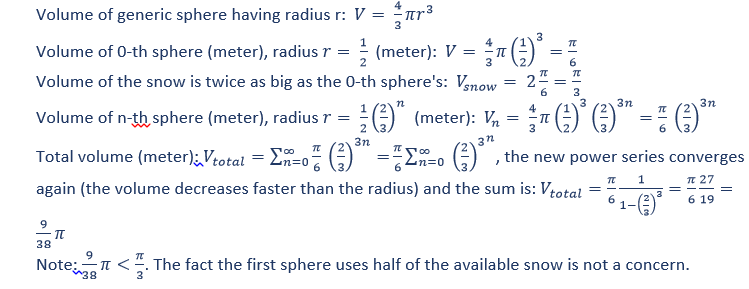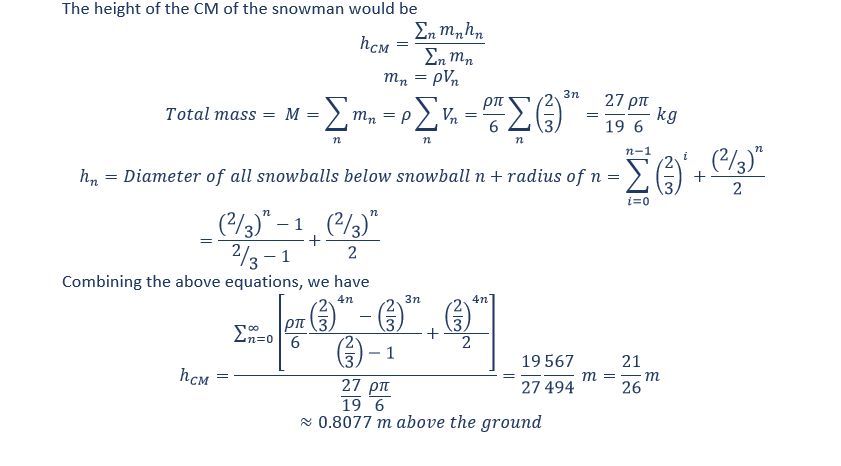December’s Infinite Snowman Geek Challenge winner is John Jacobsma of Dickson. Adnaan Velji of DMC also answered all questions correctly. The determination of best answer goes to John due to his elegant solution for the Center of Mass.
The correct answer to the primary questions is B, that the snowman will be 3m tall. The extra credit answers are that its construction will not consume more than the available snow, and that the belly button at the center of mass should be placed at 80.77cm.
Ultimate Snowman Height
First, to explain the snowman’s ultimate height, we have John Jacobsma’s answer:
The first problem is the sum of an infinite geometric series: 1 + 2/3 + 4/9 + 8/27 + ...
The sum of a + ar + ar^2 + ar^3 + ... is a/(1-r). It is convergent if |r| < 1. For this example, a = 1 and r = 2/3, so the sum is 3.
Extra Credit #1:
Next is the question of how much snow is used, and whether the first ball consuming ½ of the available snow is a concern. For this, assuming the snowballs are of equal density, the solution is provided by Andrea Gotti of Ingersol Machine Tool:

Extra Credit #2:
Here, I asked for a calculation of position of the center of mass of the snowman. First, we must look carefully at the definition. From Wikipedia, the center of mass of a distribution of mass in space is the unique point where the weighted relative position of the distributed mass sums to zero.
Several respondents incorrectly defined the Center of Mass as the position that half the mass is above, and half is below. Solving it this way involves splitting the lower snowball to find the height where the volume of the low ball below a point is equal to half the volume of the entire snowman, at 64.4cm above the ground. However, this definition of center of mass is incorrect. Using this method, in a system of two identical planets orbiting each other, the center of mass could be defined as any point on the line between the two planets.
There is, of course, a straight-forward power-series method of calculating the center of mass. Here is how Adnaan answered it with the power-series:

Or, you can use John Jacobsma’s insight to solve for the center of mass without employing the power series:
It is possible to solve this without resorting to the calculus, by observing that the snowballs resting on top of the first (1 m diameter) snowball are an exact 2/3 scale replica of the whole snowman.
If h is the height of the snowman's center of mass, then 1 + (2/3)*h is the height of the top part of the snowman's center of mass and 1/2 m is the height of the center of mass of the base.
Assuming the snow has uniform density, the top part of the snowman is 8/27 of the mass, and the base snowball is 19/27 of the mass. So now all we have to do is solve:
h = (19/27) * (1/2) + (8/27) * (1 + (2/3) * h)
Which simplifies to h = 21/26 or ~0.8077m.
Submit your comments to geekchallenge@dmcinfo.com.
Learn more about DMC's company culture.